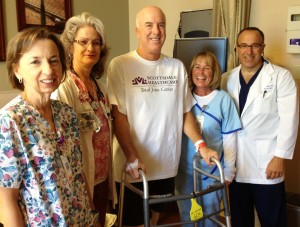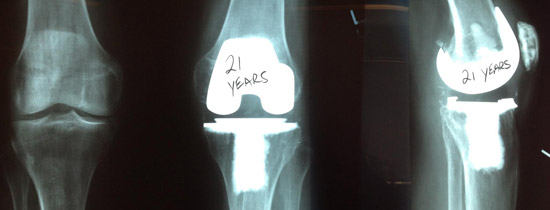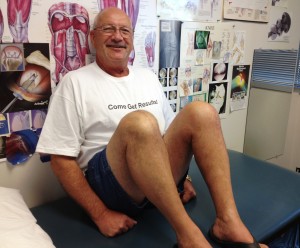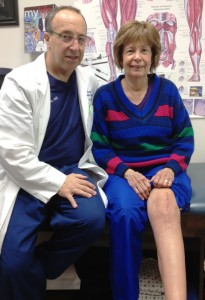Pain Management – so many patients are concerned about this. Yes it is true, total knee replacement can be a painful operation – but everyone makes it through ok in the end! We do a number of things to make our total knees less painful.
This speeds your recovery and gets you home faster. Some patients will do their own PT at home. I like functional activities, like hiking, and walking in stores with shopping carts for assistance.
Dr. Kozinn has developed his own pain management protocol. We do some things to minimize your pain – but also to maximize your complication free recovery. Unfortunately, overmedication with narcotics leads to all kinds of post-op problems..including – lethargy, nausea, constipation, itching, vomiting, light-headedness, increasd blood clots from immobility, respiratory depression, and in some cases chronic addiction. So…we try to minimize the narcotic use. We start our multi-modality pain management with Regional anesthesia whenever possible. The spinal anesthetic is the safest way to have your knee done. This is because you do not have to have a machine breathe for you, which requires lots of heavy medications – including IV narcotics. The spinal gives perfect muscle relaxation, which helps the surgeon do a better job on our knee. Also the pain comes back very gradually, making your brain deal with it better.
You can still “sleep” through your surgery, but it is a more natural sleep, from IV Versed or propofol, that still allows you to breathe on your own. In fact, the anesthesiologist could wake you up in a moment’s notice just by shaking your head and saying “Wake Up”. This is a good thing – dont worry- patients do not remember any part of the surgery – the IV sedatives have the effect of erasing the most recent memory. Most patients comes to recovery and ask “Have you started the surgery yet!?)
Also, we use a femoral nerve block – which is an injection of a “novacaine like drug” into the anterior groin area to block the femoral nerve for 24 hours. this is put in by the anesthesiologist right before the spinal anesthetic. The effect is similar to what you may have had at the dentist when he block the mandibular nerves before a tooth extraction or drilling. The nerve block also temporarily weakens the quadriceps muscle power, so it is very important to hold on to the walker or crutches when getting up the first time after surgery.
The femoral nerve block removes about 75% of the total pain to the knee, as some of the pain comes from nerve fibers coming off the sciatic nerve posterior to the knee. This is a good thing, as we need the hamstrings to be functioning to get up and walk ASAP! We inject Exparel* – a timed release pain medication into the posterior knee, which also helps a lot for up to 72 hours.
Since the pain is not severe at first ( no pain when “waking up” in the recovery room, with spinal still working – NICE! ), we use non-narcotic medications at first to dull whatever pain you may have- these drugs include – Toradol ( a very effective NSAID given IV ), Celebrex (an NSAID pill which is longer acting), IV Tylenol – (which works much faster than the pills), Tramadol ( a non-narcotic pill that has narcotic like function because it binds to the same pain receptors), Motrin and Naprosyn. We give aspirin as a blood thinner, but it also helps with the pain!
If these are not working well enough for you, particularly as the femoral nerve block begins to wear off, we start the narcotics in Pill form ( Percocet/oxycodone, Vicoden/hydrocodone, Tylenol # 4/with codeine, are the most common pills we use. We can give up to 2 pills every 3 to 4 hours, but rarely need to. Unfortunately, these pills cause nausea in so many people! That is another reason I try to hold back on them until needed. patients often tell me the nausea is much worse than the pain they were having.

The nurses on the 6 West Total joint center floor at Osborn are specially trained to take care of joint replacement patients.
You must understand the nurses were trained to treat your pain very aggressively- yet they were not really taught to consider how “over-medication” might negatively effect your overall recovery. The nurse will ask you over and over – “How much pain are you having? rate it from 1 to 10!” If you say 9 or 10, (equivalent to the worst pain you have ever experienced), she (or he) will give you more narcotics. The IV narcotics ( usually Morphine) are the most likely to cause side effects, including respiratory depression – which can lead to big problems. It is better for you to tolerate some pain – lets say up to a 4 or 5, and try to use less of the narcotic medication – this way your recovery will be faster. We can use ICE on the knee for pain, and often add anxiolytics like Valium, Xanax, Librium, Ativan – these will be better for you as they calm you down without as many side effects as the narcotics.
Your comfort and fast recovery are our major goal. Using this protocol, Dr. Kozinn has cut the hospital length of stay by a remarkable 40%. Now 1 to 2 days instead of 3 to 4! Even more importantly, we have cut the DVT rate (clots in the legs or lungs) to almost ZERO. This is because patients are able to get up and walk sooner without the lethargy from narcotics on board. Walking pumps the blood through the veins of the legs and prevents clotting. Genius! This is probably the best advance our recovery protocol has created. We also put foot pumps on your feet after surgery to keep the blood moving even in bed. Dr.Kozinn actually starts the pumps in the OR on the non-operative leg during surgery. We are serious about this stuff!
So, please bear with us. We are doing our best to control your pain without the increase in side effects. Every person is an individual, and special situations may arise ( like allergies to NSAIDS, or narcotics). Please ask us any questions about this topic that you need more information on!
Thank You
Stuarty C. Kozinn MD











